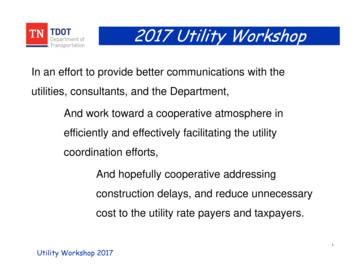Utility Of Preclinical PKPD In QT Safety Testing
Utility of preclinical PKPD modeling in QT safety testing Sandra Visser & Piet van der Graaf EMA/EFPIA M&S Workshop on the role and scope of modelling and simulation in drug development BOS1, London 1 December 2011 1
Introduction Following the development of ICH E14 there has been considerable attention to the power of clinical studies to detect drug effects on QTc However, there is no general agreement on the power of non-clinical studies to detect a given cardiovascular effect (BP, HR, QT etc) and this may contribute to concerns (raised a.o. by regulators) over the predictability of non-clinical studies – Divergent physiology and pharmacology – Definition of ‘an effect’ – What is the appropriate sensitivity to detect the desired effect Emerging approach is: – Define magnitude of effect that is a concern in humans – Define magnitude of effect in animals that predicts the effect in humans – Power the non-clinical studies to detect that magnitude of effect Translation, study design and PKPD modeling are key to success 2
Dofetilide in dogs: QT interval vs. Time Human QT prolongation Dog QT prolongation in vitro IC 50 hERG in vitro 1 30 dog % increase in QT interval 25 100 80 4 60 3 20 2 15 40 5 10 20 5 dog, present investigation 1: m an, Le Coz et al, 1995 2: m an, Abel et al., 2000 3: m an, Day 1, Allen et al., 2002 4: m an, Day 5, Allen et al., 2002 0 10 -1.0 0.0 1.0 10 10 10 unbound dofetilide concentration (nM) % inhibition hERG channel 35 0 2.0 3
Cross-species translation of Dofetilide: role of baseline Man# Dog* GP& Baseline (ms) 386 212 148 Emax (ms) 105 59 41 27 28 28 % increase 10 msec in human 5-6 msec in dog? (i.e. 3% increase from BL) #Jonker et al. 2005 *Ollerstam et al. 2006 &Pfizer internal 4
Dofetilide: apparent in vitro – in vivo potency mismatch In vitro hERG Normalized response EC50 (ng/mL) QT in man 5.13 (rSE 15%) 0.98 (rSE 10%) 1 0.75 0.5 Binding Current inhibition QT prolongation 0.25 0 0.01 0.1 1 10 100 1000 Unbound dofetilide (ng/ml) 5 5
PK/PD Model for Dofetilide: operational model of QT prolongation Mechanistic PKPD modeling approach to deduce the translational link between in vitro and clinical QTCF (msec) Operational model Dofetilide binding 0.3 500 0.2 450 0.1 400 0.0 350 0.01 0.1 1 Unbound effect site dofetilide (ng/ml) 6 Fraction bound 550 0.4
In vitro – in vivo Relationship: QT prolongation in man (msec) predicting QT risk 100 Increased risk 20 80 95% confidence interval: ’uncertainty’ 60 Inconclusive 10 40 10% inhibition of hERG current by dofetilide corresponds to 20 msec 20 QT interval prolongation (95% CI: 12-32 msec) ’Safe’ 0 0 0 0.1 0 0.05 0.2 0.1 0.3 Normalized response in hERG assay 7
Moxifloxacin: Concentration-Effect Modelling as a Translational Tool In vitro Æ Man Preclinical Æ Man hERG human cyno Area of interest Area of interest 8
Consistent translation between in vitro and in vivo to dog Pfizer Compound hERG IC20 μM Modelled [μM] for 10 msec change in dog Fraction of hERG IC20 A B C D E F Moxi 6.9 0.57 2.04 1.6 16.7 2.5 12.8 2.3 0.29 0.63 0.4 7.6 2.2 3.5 0.33 0.51 0.31 0.23 0.45 0.9 0.27 9
Prediction of the human QT safety profiles of new drug candidates 5% hERG Æ 5 msec dog/monkey Æ 10 msec humans Demonstrated for number of compounds (internal Pfizer) and between companies (AZ & Pfizer) Important issues to address Experimental design to optimally and reliably detect small changes – hERG assay harmonization – PKPD design of in vivo dog studies – Clinical study design for QT assessement based on preclinical knowledge Data analysis – QT correction (individual, baseline, vehicle, serial correlation) – Model-based analysis of hysteresis Validation of human prediction – Retro- and pro-spective predictions – Build in vitro- vivo and clinical relationship for non selective hERG blockers 10
Experimental design Validate link between hERG protocol and in vivo results – Large differences in hERG protocols between companies – Build case for non-selective hERG blockers / multi channel screen In vivo study design based on PKPD principles – Gradual infusion of the compound and recording of washout phase at two or more dose levels. – Acclimatization of the dog to the experimental situation to reduce the influence of rapid changes in autonomic tone on the QT interval – Ex vivo assessment of plasma protein binding determination to facilitate the kineticdynamic analysis are considered essential for the estimation of the QT interval safety margin – PKPD modeling: allow a thorough kinetic-dynamic analysis in order to generate the true unbound concentration- response relationship at equilibrium accounting for hysteresis. Harmonization discussions – Best practice meetings Safety Pharmacology Society, Sept 2010 – Pfizer interactions with FDA – Top Institute Pharma workpackage CV/Safety: recommendations by 2012 11
Example dog QT interval correction 1. 2. 3. 4. 5. 6. 7. 8. Bazett Friedricia Van de Water Individual exponent Linear Davies and Middleton Raunig Gompertz QT interval-heart rate relationship and vehicle response were individual-specific and corrections should therefore be made individually using a linear model
Lag time in QT interval adaptation to an abrupt decrease in heart rate Mean se QT Emax (ms) t1/2 (s) QTss 75% (s) QTss 90% (s) 19 2 27 5 54 9 89 15 QT interval data after abrupt changes in heart rate should be excluded from the analysis due to delay in the QT interval response
Hysteresis: Model Based Approach needed for correct assessment of QT QTc effect of PF-A in dog Very commonly observed in preclinical QT testing and also common for other CV endpoints: BP, HR, Contractility 30 min infusion 275 Extend ranges from minutes to hours and can vary between compounds from same program 270 265 Can provide important information about MOA and hence guide risk management strategy: – – – Direct or indirect effect Target related or not Metabolite Limited information available regarding translation to man Ignoring hysteresis may lead to incorrect estimation of QT safety window 260 255 -60 0 60 120 180 240 Time (min) Time-course of effect 275 Concentration-effect 270 265 260 255 PKPD analysis of the individual concentration-effect relationship and confounding factors such as hysteresis provides a better prediction of the safety profiles of new drug candidates 0 5 10 15 20 25 30 35 40 Cfree (nM) 14 45
Preclinical PKPD for CV Safety Testing: Value proposition Application of PKPD principles and methods can increase effectiveness and efficiency of preclinical cardiovascular safety testing: – Increased confidence in safety assessment and definition of safety margin through characterization of concentration-effect relationship – Support mechanistic interpretation of findings through better understanding time-course of effect – More efficient study design and data analysis can help to reduce use of animals (3R’s principles) PKPD models provide common language for translational safety pharmacology between species: – Utilise preclinical PKPD models to guide human trial design 15
Discussion (How) Can preclinical PKPD safety studies provide a basis for a risk management strategy that does not involve TQT? 16
Dog QT prolongation in vitro IC 50 hERG 10-1.0 10 0.0 10 1.0 10 2.0 unbound dofet ilide concentration (nM) 0 5 10 15 20 25 30 35 % increase in QT interval dog, present investigation 1: man, Le Coz et al, 1995 2: man, Abel et al., 2000 3: man, Day 1, Allen et al., 2002 4: man, Day 5, Allen et al., 2002 0 20 40 60 80 100 % inhibition hERG channel .
i. Definition of Utility Mapping. ii. History of Utility Mapping. iii. Objectives of Utility Survey & Mapping in Malaysia. iv. The scope of Utility Mapping in standard guidelines for underground utility mapping. v. The role of utility owner, surveyor and JUPEM in underground utility mapping. 1 UNDERSTAND THE UTILITY QUALITY LEVEL ATTRIBUTES i.
The Preclinical Speech Science Workbook, Third Edition is a natural companion to the Preclinical Speech Science, Third Edition textbook. it has been carefully designed to help students rein-force, integrate, apply, and go beyond the material presented in the textbook. The workbook contains a wide variety of activities. These include anatomic .
Feb 09, 2011 · clinical protocol Prepare and file IND Clinical Candidate 8 Preclinical Therapeutics Stage Gates Preclinical Toxicology and Pharmacology are required for decision-making throughout drug discovery and development and for IND filing for clinical trials
One direct consequence of this is that the utility of a lottery is the expected utility of the outcomes. So, the utility of our standard simple lottery L is p times the utility of A plus (1-p) times the utility of B. Once we know how to compute the utility of a simple lottery like this, we can also compute the utility of very complex lotteries.
Utility Workshop 2017 JH A. Introduction – Schedules / Housekeeping / Website / TEAMS / Region Staff B. Utility Opportunities for Participation . Shawn Allen HQ Utility/Railroad Support Joan Haynes HQ Utility Early Notify Jay Lanius HQ Railroad Coordinator Region Staff: Gus Awali Rg Utility Coordinator Region 1 .
3. Check trailer brake lights and turn signals. 4. Check UTILITY VAC fuel level. 5. Make certain battery is charged and ready to start UTILITY VAC engine. 6. Make certain suction hose and suction tubes are stored on board UTILITY VAC UTILITY VAC SET UP PROCEDURE: 1. Position UTILITY VAC n
ProSAFE Plus Configuration Utility (PCU) for multi-switch management Yes Firmware upgrade TFTP (Plus Utility) / HTTP (Web GUI) Config file transfers (backup, restore) Plus Utility or Web GUI Firmware upgrade through Plus Utility (TFTP) Yes Config download (to switch) through Plus Utility Yes Config upload (to server) through Plus Utility Yes
This dissertation is about the Loyalist Regiments of the American Revolution, 1775-1783. These were the formal regiments formed by the British, consisting of Americans who stayed Loyal to the British crown during the American Revolutionary War. They fought in most of the main campaigns of this war and in 1783 left with the British Army for Canada, where many of them settled. The Loyalist .























